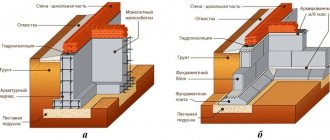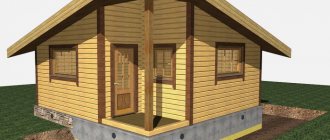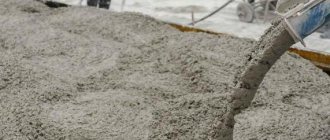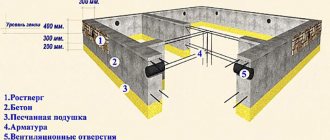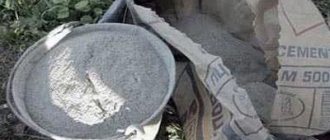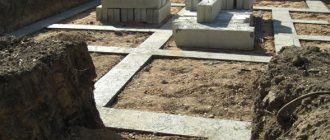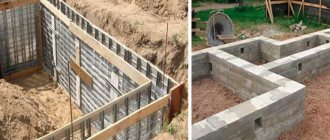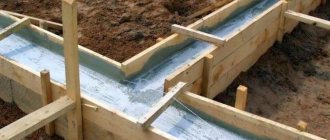The construction of any building begins with developing a project, determining the need for materials, and calculating the estimated cost. Before starting work, it is important to choose the right type and design of the foundation, which will ensure the stability and durability of the structure. Knowing the parameters of the designed foundation, the calculator will allow you to quickly calculate the amount of concrete, as well as determine the need for steel reinforcement and other necessary materials. For calculations, you can use an online concrete foundation calculator or do the calculations yourself.
How to calculate the foundation for a house
How to correctly determine the consumption of materials for the foundation - getting ready to perform calculations
Before starting construction activities, it is important to correctly determine the need for building materials. This will allow you to plan the amount of costs and rationally use available financial resources. Since the construction of houses is preceded by the construction of the foundation, it is necessary at the initial stage to calculate the volume of concrete mixture required for pouring the foundation. In order to perform foundation calculations, a calculator is required.
You can perform calculations in different ways:
- using a ready-made program. A foundation calculator posted on professional websites will help speed up calculations;
- performing the calculation manually. It is easy, using a regular calculator, to calculate the amount of concrete for the foundation with a high degree of accuracy.
When performing calculations, it is necessary to take into account that the amount of concrete solution is measured in cubic meters, and not in liters or tons. Taking this into account, in the process of calculations we will obtain the volume of the concrete composition, and not the weight. Before starting calculations, you should decide on the type and design of the foundation.
To do this, you need to perform a number of activities:
- carry out geodetic surveys. They help determine the level of groundwater, soil characteristics and freezing depth;
- determine the loads acting on the base. The calculator posted on the website will help you correctly and quickly calculate the foundation for a house.
Calculation of the foundation using the example of a 6x4 meter bath
Having calculated the amount of concrete for the foundation, the calculator will take into account the following data :
- type of foundation being constructed. The professional program allows you to calculate the strip base, slab base and columnar structure;
- foundation design and dimensions. The configuration and dimensions depend on the characteristics of the building, the operating loads and soil characteristics;
- the brand of concrete mortar used for pouring. It is selected depending on the level of mechanical loads;
- soil freezing level. It is determined taking into account the territorial location of the construction site.
The correctness of the calculation of the solution, as well as the consumption of materials, depends on the completeness of the entered data.
How to do the calculation yourself
Any calculation of the cubic capacity of the foundation is done based on the basic formulas: width x height x length = volume or area x height = volume. But if the shape of the foundation is uneven, like a parallelepiped, then the trapezoid formula is used: (Bottom width + Top width)/2 x height x length = volume.
All dimensions must be measured when the formwork is ready, directly along it. But you can see the specified dimensions in the house plan if the foundation was calculated there. If not, then you can draw a foundation diagram yourself and perform calculations on it. When calculating, it is important to take into account all elements that can affect the cubic capacity, for example, stiffeners. When calculating each foundation design, there are subtleties.
Cubic capacity of slab structure
This type of foundation consists of a single slab located under the house. It is easiest to calculate a slab foundation. It is enough to draw a parallelepiped and calculate its volume. Therefore, the formula will be: area x height = volume. So, if the width of the foundation is exactly 15 meters, the length is 10 meters and the height is 1 meter, then it turns out 10 x 15 x 1 = 150 m3.
If the planned foundation has additional stiffeners, then they need to be calculated separately and added to the main figure. For example, 3 stiffeners are planned, 5 meters long, 0.2 meters wide and 0.25 meters high. The volume of concrete on these ribs is 5 x 0.2 x 0.25 x 3 = 0.75 m3. But we know that the total cubic capacity is 150 m3, which means that 150.75 m3 of concrete is needed for construction.
If there are voids in the foundation, then their total volume is also calculated separately and subtracted from the total.
Capacity of the strip base
A strip foundation is most often installed for the construction of a house made of profiled timber or rounded logs. Since the structure is lightweight and does not require a reinforced foundation. It is more difficult to calculate. Moreover, the height of the strip foundation may depend on several factors at once (depth of water, uneven terrain, etc.), which may differ for one foundation. So the height will be different everywhere. The width may also vary depending on the complexity of the design. Moreover, the strip foundation can be either rectangular or in the form of a trapezoid, narrowing, or expanding towards the bottom. You need to calculate the volume based on its shape.
In such cases, areas with identical indicators are combined and their volume is calculated separately, and then summed up. The length of the foundation is calculated not by its length, but by the average figure between the outer walls of the formwork. This way you can avoid unnecessary costs for concrete. In this case, the volume of all voids is subtracted from the total volume.
Cubic capacity of columnar base
When calculating cubic capacity in this way, you need to take into account what shape the column has. It can be square, four-sided, truncated pyramid or round. The volume of a cylinder should be calculated using the formula: Pi x radius 2 x height = volume. The number Pi is always equal to 3.14. For example, a pillar has a height of 2 meters, its radius is 0.65 meters. We calculate the volume of concrete cubes: 3.14 x 0.622 x 2 = 2.41 meters3 per 1st column. We multiply this number by the number of pillars and get the required volume of concrete.
If there is a strapping between the pillars, then its volume is calculated separately and the number of columns is added.
In order for the calculations to be carried out correctly, so that it does not turn out that in the end there is not enough solution or extra money is spent, a number of subtleties must be taken into account:
- For any work, concrete loss will be 5-8%. This must be taken into account when calculating.
- Instead of crushed stone, you can add ASG to concrete, so the solution will be cheaper.
- For a wooden house, a foundation depth of 0.5 m is sufficient, since the structure is light.
- For the construction of a one-story country house from timber, a mortar of M 150 will be used, for a residential building over M 200.
- It is always more expensive to purchase ready-mixed concrete.
No matter how the calculations are made, on a calculator or by hand, you need to recalculate and check the result several times. For any minor change in the foundation design, the calculation should be carried out again.
What initial data are included in the calculator for calculating the foundation for a house?
Wanting to determine the total cost and calculate the need for materials, it is important to understand how to calculate the foundation for a house.
The calculator used to perform the calculation processes a large amount of information for each type of basis:
- for a strip-type foundation base, it is necessary to take into account the dimensions of the strip, as well as its configuration;
- for a columnar base, information is processed on the number of supporting elements, their length, cross-sectional dimensions and immersion depth;
- for a structure in the form of a monolithic slab, it is necessary to take into account the thickness of the base, the area of the structure being built, as well as the design features of the frame.
Configuration and calculation results of a solid foundation
After the calculation of materials for the foundation has been performed, the calculator will be able to provide the following information :
- volume of required concrete solution;
- footage of rods (m) and total weight of reinforcement (kg);
- range of reinforcement for the frame;
- the magnitude of the load on the ground;
- the need for wood for the manufacture of formwork.
Based on the results of online calculations, you can also obtain information about the dimensions of the spatial reinforcement frame.
Calculation of a strip foundation for a house - calculator
To determine the volume of concrete composition and calculate the need for materials, it is important to consider the following points:
- the length of the base, which must correspond to the perimeter of the building;
- the width of the tape, which should exceed the thickness of the walls by 10–15 cm;
- level of penetration into the soil corresponding to the characteristics of the soil.
Calculation of a strip foundation
By multiplying the indicated values, we obtain the volume of the foundation strip corresponding to the cubic capacity of concrete. Knowing the mass of a cubic meter of reinforced concrete, equal to 2.4–2.5 tons, it is not difficult to obtain the weight of the base. To do this, you need to multiply the total cubic capacity by the weight of one cubic meter of base. When performing calculations manually, there is a small error of 6–8%. It is important to accurately calculate the solution for the foundation. The calculator, which can be used online, provides this opportunity.
How to calculate materials for a columnar foundation
When building a columnar foundation, it is necessary to correctly calculate the foundation for the house.
The online calculator processes the following data::
- number of support columns;
- diameter and height of piles;
- dimensions of the expanded part of the support located in the ground;
- grillage dimensions;
- grillage structure configuration;
- brand of concrete mixture used.
Using available information about the design features and dimensions of the pile foundation, calculations can be made manually. To do this, you need to determine the volume of one support and multiply the resulting value by the total number of piles. The volume of the grillage is calculated similarly to the tape base. By adding the volume of the supports with the volume of the grillage, we obtain the total volume of the pile structure. Now calculating the amount of concrete is not difficult.
Calculation of concrete cubic capacity for a slab base
The shape of the slab foundation resembles a rectangular parallelepiped . Measuring its edges can be done according to design drawings or using ready-made formwork. To obtain the most accurate results, it is recommended to use the second measurement option. Calculating the volume of concrete is very simple: the area of the base is multiplied by the height of the formwork. The area of the sole is determined by multiplying the length and width of the grillage.
stiffeners are laid into it . This is done to add strength and increase the load-bearing capacity of the base. Therefore, for more accurate calculations, the volumes of the ribs should be calculated separately, and then the volume of the reinforcing structures should be subtracted from the resulting cubic capacity of the base.
Concrete calculator for a foundation in the form of a monolithic slab
Calculation of materials for a slab foundation
When planning to concrete a monolithic slab, developers are faced with the problem of how to calculate the amount of concrete for the foundation.
The calculator allows you to quickly determine the consumption of concrete mixture after entering the following parameters into the appropriate columns of the program:
- length of the slab base;
- width of the foundation slab;
- height of the reinforced concrete base.
By performing calculations manually, you can neglect the volume occupied by the reinforcement cage. You just need to multiply the dimensions of the structure and get its volume, which approximately corresponds to the need for concrete composition. To obtain accurate values, it is necessary to use software methods.
Types of concrete
The following types of solution are distinguished:
- By appointment. These include ordinary and special solutions. The former are used for the construction of industrial and civil buildings, while special ones are used for the construction of hydraulic, road and other structures.
- By binder. These include cement, gypsum, silicate solutions, etc.
- By placeholders. There are concrete with dense, porous and special additives.
- According to hardening conditions. They are divided into hardening in a natural environment, under conditions of wet and warm processing at normal atmospheric pressure, and during processing with heat and moisture at atmospheric pressure above normal (autoclave hardening).
Calculation of materials for the foundation (calculator) - determine the need for cement
When preparing concrete mortar, various grades of cement are used as a binder. The strength, reliability and service life of building structures depend on the characteristics and quantity of Portland cement introduced into the concrete mixture. When calculating the material for the foundation, the calculator, which is a special program, processes a set of initial data and provides information about the need for cement for the foundation.
Material calculator for a monolithic foundation slab
Using reference data, you can independently determine the amount of cement for preparing concrete mortar. It is important to consider the proportion according to which sand, cement and crushed stone are mixed. This ratio is 3:1:5. The concrete solution is formed from 9 parts, one of which is Portland cement.
Based on this ratio, the number of different grades of cement per cubic meter of concrete is determined.:
- M100 is used in quantities of 160–200 kg;
- M150 requires 200–220 kg;
- M200 is added at 240–280 kg;
- M250 is introduced at 300–330 kg.
As the grade of Portland cement increases, its quantity per cubic meter of concrete composition increases and amounts to:
- M300 – 320–380 kg;
- M400 – 400–420 kg;
- M500 – 510–530 kg.
This information allows you to independently determine the need for cement with a high degree of accuracy. There is also a special online program that will quickly perform calculations after entering the required volume of the finished concrete mixture, the grade of concrete and the type of cement used.
Calculation of concrete mixture composition
In the article about concrete for foundations, we described in sufficient detail the characteristics of the concrete mixture and how they affect the reliability and strength of the monolith built from them. But the data presented there is clearly not enough to make the required amount of concrete with your own hands. When calculating the percentage composition of a concrete mixture, there are no trifles: you need to take into account the water-cement ratio (W/C), the characteristics of the aggregates (sand and crushed stone), and the brand of cement used. Where to start?
Let's say we need to get M300 grade concrete from M400 Portland cement. We look at the values presented in table 1. It can be seen from it that the water-cement ratio is 0.53. These tables are relevant for a concrete mixture prepared on the basis of crushed stone and sand, the particle size modulus of which does not exceed 2.5 - components with an average grain size. If we need to prepare a concrete solution without crushed stone filler, then 0.1 must be subtracted from the W/C value. In our case, it turns out that the water-cement ratio will be equal to 0.43. What does it mean? In the first case (W/C = 0.53), when using 50 kg of cement, it is necessary to add 50 × 0.53 = 26.5 liters of water to the mixture, in the second (W/C = 0.43) - 21.5 liters. But we just explained the term “water-cement ratio”. Let's move on to a specific example.
It is necessary to obtain: 10 cubes of concrete M300 with mobility P2 (cone slump up to 50 mm)
Available:
- crushed stone (maximum grain size – 25 mm), density – 2700 kg/m3
- medium sand, density – 2500 kg/m3
- Portland cement M400, the density of which in the water-cement mass is 3000 kg/m3
Using Table 1, we find the W/C value to obtain the design grade of concrete M300. It is equal to 0.53. We look at the data in Table 2. It indicates that when using crushed stone with a maximum grain size of 25 mm, 195 liters of water (or 0.195 m3) are required to prepare one cube of concrete. It turns out that for 1 cubic meter of concrete you will need: 195/0.53=368 kg of cement Next, you need to calculate how much volume per cubic meter fillers (sand and crushed stone) occupy: 1-((368/3000)+0.195)=0.682 m3 or 682 liters Now, using the data in Table 2, we find the volumetric content of sand in the filler mixture. In our case it is equal to 46% or simply 0.46. Knowing it, it is easy to calculate the volume of sand: 682×0.46=313.7 liters or 0.314 m3. We subtract the volume of sand from the total volume of fillers and get the volume of crushed stone: 682-313.7=368.3 liters or 0.368 m3 Knowing the volumes of fillers and density, it is easy to calculate their mass. So, for sand it will be: 0.314×2500=785 kg, for crushed stone - 0.368×2700=993.6 kg.
In total, to prepare one cubic meter of concrete mix of design grade M300 from Portland cement M400 you will need:
368 kg of cement, 195 liters of water, 785 kg of sand, 993.6 kg of crushed stone
To prepare ten cubes, the obtained values must be multiplied by 10. This data is used to adjust the calculation of the foundation. You can also express the mass ratio of cement, sand and crushed stone:
368/785/993,6 = 1:2,1:2,7
Using Table 3, we made sure that the calculated mass of cement is not less than the tabulated values indicated for the preparation of M300 concrete mixture with a cone slump of up to 50 mm (P2) from M400 cement.
Calculation of the foundation for a house - cost calculator
How to calculate the foundation of a house yourself
Having decided on the methodology for calculating the amount of concrete mortar and the Portland cement used for its production, you can begin to determine the overall level of costs for constructing the foundation.
Total costs include the costs of purchasing the following materials:
- medium-sized river or quarry sand;
- Portland cement of the required grade;
- medium-fraction crushed stone.
It is also necessary to take into account the purchase costs:
- steel reinforcement intended for the manufacture of the frame;
- boards, plywood panels or metal for assembling formwork;
- tying wire used to join steel rods;
- hardware used to assemble the formwork structure.
An important element of the calculation is the transportation costs associated with the delivery of the necessary materials to the construction site.
